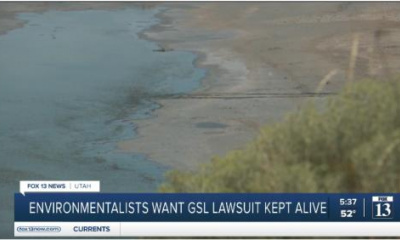State points to millions invested and ongoing efforts to rescue its imperiled inland sea, noting litigation “cannot solve every problem.”
Environmental groups sued Utah in an effort to save the shrinking Great Salt Lake, but state officials claim they’re already working hard to prevent its collapse.
Utah Physicians for a Healthy Environment, Utah Rivers Council, the Center for Biological Diversity, the Sierra Club and the American Bird Conservancy filed their lawsuit against the state agencies in September. The plaintiffs seek to compel Utah’s resource managers to curb water diversions until the Great Salt Lake rises to 4,198 feet above sea level — about 6 feet higher than the lake’s southern half sits today.
The Utah Department of Natural Resources, Division of Water Rights and Division of Forestry, Fire and State Lands filed separate motions to dismiss the case Wednesday in 3rd District Court.
“The state shares the plaintiffs’ concern for a healthy Great Salt Lake and the surrounding environment,” DNR wrote in a news release. “Litigation, however, cannot solve every problem, and indeed, directs important resources away from efforts to conserve and enhance the lake.”
In the motions to dismiss, state resource managers argue they’re already going to great lengths to keep the lake functional.
Lawmakers have invested $500 million in protecting the lake and its watershed. The Legislature created a trust to buy or lease water rights — although the program has seen few participants sign up so far. It appointed a Great Salt Lake commissioner to coordinate the lake’s rescue response. It implemented a multimillion-dollar water optimization program for agriculture, although the Department of Agriculture and Food has not yet tracked if that effort helps the Great Salt Lake.
The governor also closed much of the lake’s watershed to new water appropriations, but a carve out left the door open for a powerful lawmaker to drill wells for his ranch near the lake’s shore.
In its motions to dismiss, the state further claims the environmental groups’ solution for saving the lake — curtailing diversions — would “would run roughshod” over existing water rights, property rights and water law.
“Water law, especially in Utah, is complex,” the state agencies note in their filings. “Plaintiffs’ blunt proposed remedy (mandatory upstream curtailments) would undermine prior appropriated rights (enshrined in the Constitution) and directly impair the State’s myriad efforts, already in the works, to bolster the Lake.”
But the coalition of lake advocates who filed the case argue the state has a duty to manage the lake for the public trust, or the good of all Utahns, in addition to managing and upholding water rights.
“We’ve reviewed the state’s arguments and find them to be unpersuasive,” said Scott Stern, an attorney with Earthjustice who represents the coalition, “especially in light of the escalating crisis at the Great Salt Lake.”
The lake hit record lows twice, in 2021 and 2022, and spiking salinity pushed its brine flies, brine shrimp and the millions of birds that depend on them to the brink of collapse. State resource managers filled in a rock-filled causeway last year in an effort to prevent further ecological damage, effectively cutting the lake in half.
The plaintiffs’ case leans on the so-called “public trust doctrine,” which environmental advocates successfully used in the 1980s to save Mono Lake from getting sucked dry by the City of Los Angeles.
But the Great Salt Lake is much bigger than Mono Lake, and the legal issues around it are a lot more knotty. Instead of a single party siphoning away its water, the Great Salt Lake Basin has a multitude of water users that support cities, farmers and industry.
Indeed, numerous water rights holders have filed motions to intervene in the lawsuit, including Salt Lake City, Provo City, Rocky Mountain Power, several large water districts and multiple canal companies.
“We hope this litigation moves as quickly as possible because time is of the essence,” Stern said. “We are planning on responding [to the dismissal motions] at great length.”






